Transparent Metasurface for Generating Microwave Vortex Beams with Cross-Polarization Conversion
Abstract
:1. Introduction
2. Design of the Metasurface
3. Results
4. Conclusions
Author Contributions
Funding
Conflicts of Interest
References
- Yan, Y.; Xie, G.D.; Lavery, M.P.J.; Huang, H.; Ahmed, N.; Bao, C.J.; Ren, Y.X.; Cao, Y.W.; Li, L.; Zhao, Z.; et al. High-capacity millimetre-wave communications with orbital angular momentum multiplexing. Nat. Commun. 2014, 5, 4876. [Google Scholar] [CrossRef] [PubMed] [Green Version]
- Hui, X.N.; Zheng, S.L.; Chen, Y.L.; Hu, Y.P.; Jin, X.F.; Chi, H.; Zhang, X.M. Multiplexed Millimeter Wave Communication with Dual Orbital Angular Momentum (OAM) Mode Antennas. Sci. Rep. 2015, 5, 10148. [Google Scholar] [CrossRef] [PubMed] [Green Version]
- Mahmouli, F.E.; Walker, S.D. 4-Gbps Uncompressed Video Transmission over a 60-GHz Orbital Angular Momentum Wireless Channel. IEEE Wirel. Commun. Lett. 2013, 2, 223–226. [Google Scholar] [CrossRef]
- Liu, K.; Cheng, Y.Q.; Yang, Z.C.; Wang, H.Q.; Qin, Y.L.; Li, X. Orbital-Angular-Momentum-Based Electromagnetic Vortex Imaging. IEEE Antennas Wirel. Propag. Lett. 2015, 14, 711–714. [Google Scholar] [CrossRef]
- Liu, K.; Cheng, Y.Q.; Gao, Y.; Li, X.; Qin, Y.L.; Wang, H.Q. Super-resolution Radar Imaging Based on Experimental OAM Beams. Appl. Phys. Lett. 2017, 116, 164102. [Google Scholar] [CrossRef]
- Cheng, L.; Hong, W.; Hao, Z.C. Generation of Electromagnetic Waves with Arbitrary Orbital Angular Momentum Modes. Sci. Rep. 2014, 5, 4814. [Google Scholar] [CrossRef]
- Chen, Y.; Zheng, S.; Li, Y.; Hui, X.; Jin, X.; Chi, H.; Zhang, X. A Flat-Lensed Spiral Phase Plate Based on Phase-shifting Surface for Generation of Millimeter-wave OAM Beam. IEEE Antennas Wirel. Propag. Lett. 2015, 15, 1156–1158. [Google Scholar] [CrossRef]
- Hui, X.; Zheng, S.; Hu, Y.; Xu, C.; Jin, X.; Chi, H.; Zhang, X. Ultralow Reflectivity Spiral Phase Plate for Generation of Millimeter-wave OAM Beam. IEEE Antennas Wirel. Propag. Lett. 2015, 14, 4876. [Google Scholar] [CrossRef]
- Bai, Q.; Tennant, A.; Allen, B. Experimental Circular Phased Array for Generating OAM Radio Beams. Electron. Lett. 2014, 50, 1414–1415. [Google Scholar] [CrossRef]
- Mohammadi, S.M.; Daldorff, L.K.S.; Bergman, J.E.S.; Karlsson, R.L.; Thide, B.; Forozesh, K.; Carozzi, T.D.; Isham, B. Orbital Angular Momentum in Radio-A System Study. IEEE Trans. Antennas Propag. 2010, 58, 565–572. [Google Scholar] [CrossRef]
- Barbuto, M.; Trotta, F.; Bilotti, F.; Toscano, A. Circular Polarized Patch Antenna Generating Orbital Angular Momentum. Prog. Electromagn. Res. 2014, 148, 23–30. [Google Scholar] [CrossRef]
- Ren, J.; Leung, K.W. Generation of microwave orbital angular momentum states using hemispherical dielectric resonator antenna. Appl. Phys. Lett. 2018, 112, 131103. [Google Scholar] [CrossRef]
- Chavez-Cerda, S.; Padgett, M.J.; Allison, I.; New, G.H.C.; Gutierrez-Vega, J.C.; O’Neil, A.T.; MacVicar, I.; Courtial, J. Holographic generation and orbital angular momentum of high-order Mathieu beams. J. Opt. B-Quantum Semicl. Opt. 2002, 4, S52–S57. [Google Scholar] [CrossRef]
- Feng, R.; Yi, J.J.; Burokur, S.N.; Kang, L.; Zhang, H.L.; Werner, D.H. Orbital angular momentum generation method based on transformation electromagnetics. Opt. Express 2018, 26, 11708–11717. [Google Scholar] [CrossRef] [PubMed]
- Chen, M.L.N.; Jiang, L.J.; Sha, W.E.I. Artificial perfect electric conductor-perfect magnetic conductor anisotropic metasurface for generating orbital angular momentum of microwave with nearly perfect conversion efficiency. J. Appl. Phys. 2016, 119, 064506. [Google Scholar] [CrossRef] [Green Version]
- Chen, M.; Jiang, L.J.; Sha, W.E.I. Ultrathin Complementary Metasurface for Orbital Angular Momentum Generation at Microwave Frequencies. IEEE Trans. Antennas Propag. 2017, 65, 396–400. [Google Scholar] [CrossRef] [Green Version]
- Zhang, L.; Mei, S.T.; Huang, K.; Qiu, C.W. Advances in Full Control of Electromagnetic Waves with Metasurfaces. Adv. Opt. Mater. 2016, 4, 818–833. [Google Scholar] [CrossRef] [Green Version]
- Yu, S.X.; Li, L.; Shi, G.M.; Zhu, C.; Zhou, X.X.; Shi, Y. Design, fabrication, and measurement of reflective metasurface for orbital angular momentum vortex wave in radio frequency domain. Appl. Phys. Lett. 2016, 108, 121903. [Google Scholar] [CrossRef]
- Yu, S.X.; Li, L.; Shi, G.M. Dual-polarization and dual-mode orbital angular momentum radio vortex beam generated by using reflective metasurface. Appl. Phys. Express 2016, 9, 082202. [Google Scholar] [CrossRef]
- Yang, J.; Zhang, C.; Ma, H.F.; Zhao, J.; Dai, J.Y.; Yuan, W.; Yang, L.X.; Cheng, Q.; Cui, T.J. Generation of radio vortex beams with designable polarization using anisotropic frequency selective surface. Appl. Phys. Lett. 2018, 112, 203501. [Google Scholar] [CrossRef]
- Yu, S.X.; Li, L.; Shi, G.M.; Zhu, C.; Shi, Y. Generating multiple orbital angular momentum vortex beams using a metasurface in radio frequency domain. Appl. Phys. Lett. 2016, 108, 241901. [Google Scholar] [CrossRef]
- Zhang, C.; Deng, L.; Zhu, J.; Hong, W.; Wang, L.; Yang, W.; Li, S. Control of the Spin Angular Momentum and Orbital Angular Momentum of a Reflected Wave by Multifunctional Graphene Metasurfaces. Materials 2018, 11, 1054. [Google Scholar] [CrossRef] [PubMed]
- Wang, L.; Shi, H.; Zhu, S.; Li, J.; Zhang, A.; Li, L. Generation of multiple modes microwave vortex beams using tunable metasurface. In Proceedings of the 2017 7th IEEE International Symposium on Microwave, Antenna, Propagation, and EMC Technologies (MAPE), Xi’an, China, 24–27 October 2017; pp. 379–381. [Google Scholar]
- Jiang, Z.H.; Kang, L.; Hong, W.; Werner, D.H. Highly Efficient Broadband Multiplexed Millimeter-Wave Vortices from Metasurface-Enabled Transmit-Arrays of Subwavelength Thickness. Phys. Rev. Appl. 2018, 9, 064009. [Google Scholar] [CrossRef]
- Chen, M.L.N.; Jiang, L.J.; Sha, W.E.I. Orbital Angular Momentum Generation and Detection by Geometric-Phase Based Metasurfaces. Appl. Sci. 2018, 8, 362. [Google Scholar] [CrossRef]
- Bliokh, K.Y.; Bekshaev, A.Y.; Nori, F. Dual electromagnetism: Helicity, spin, momentum and angular momentum. New J. Phys. 2013, 15, 033026. [Google Scholar] [CrossRef]
- Liu, Y.J.; Xia, S.; Shi, H.Y.; Zhang, A.X.; Xu, Z. Dual-band and high-efficiency polarization converter based on metasurfaces at microwave frequencies. Appl. Phys. B-Lasers Opt. 2016, 122, 178. [Google Scholar] [CrossRef]
- Dong, G.X.; Shi, H.Y.; Xia, S.; Li, W.; Zhang, A.X.; Xu, Z.; Wei, X.Y. Ultra-broadband and high-efficiency polarization conversion metasurface with multiple plasmon resonance modes. Chin. Phys. B 2016, 25, 084202. [Google Scholar] [CrossRef]
- Ran, Y.Z.; Liang, J.G.; Cai, T.; Li, H.P. High-performance broadband vortex beam generator using reflective Pancharatnam-Berry metasurface. Opt. Commun. 2018, 427, 101–106. [Google Scholar] [CrossRef]
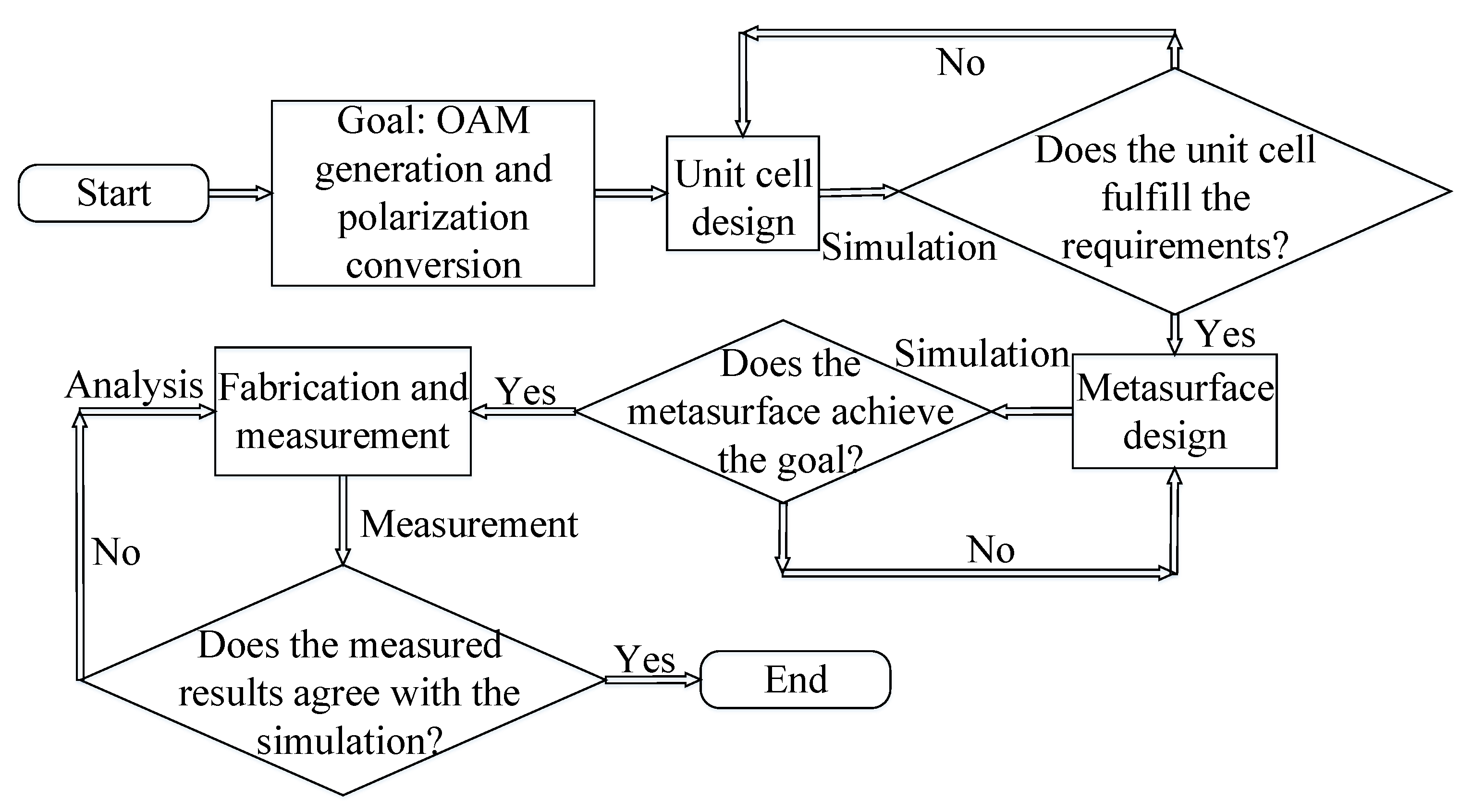
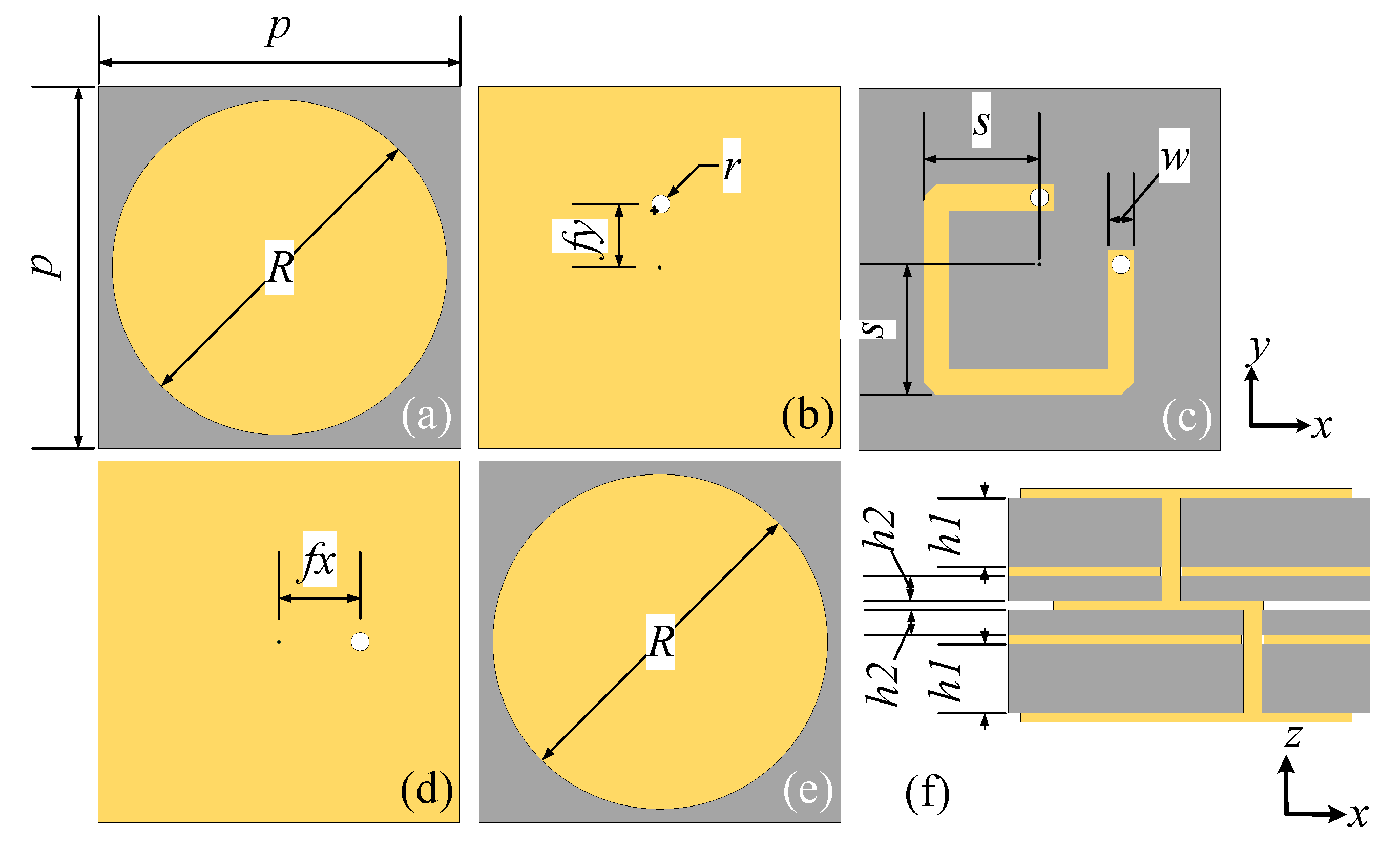


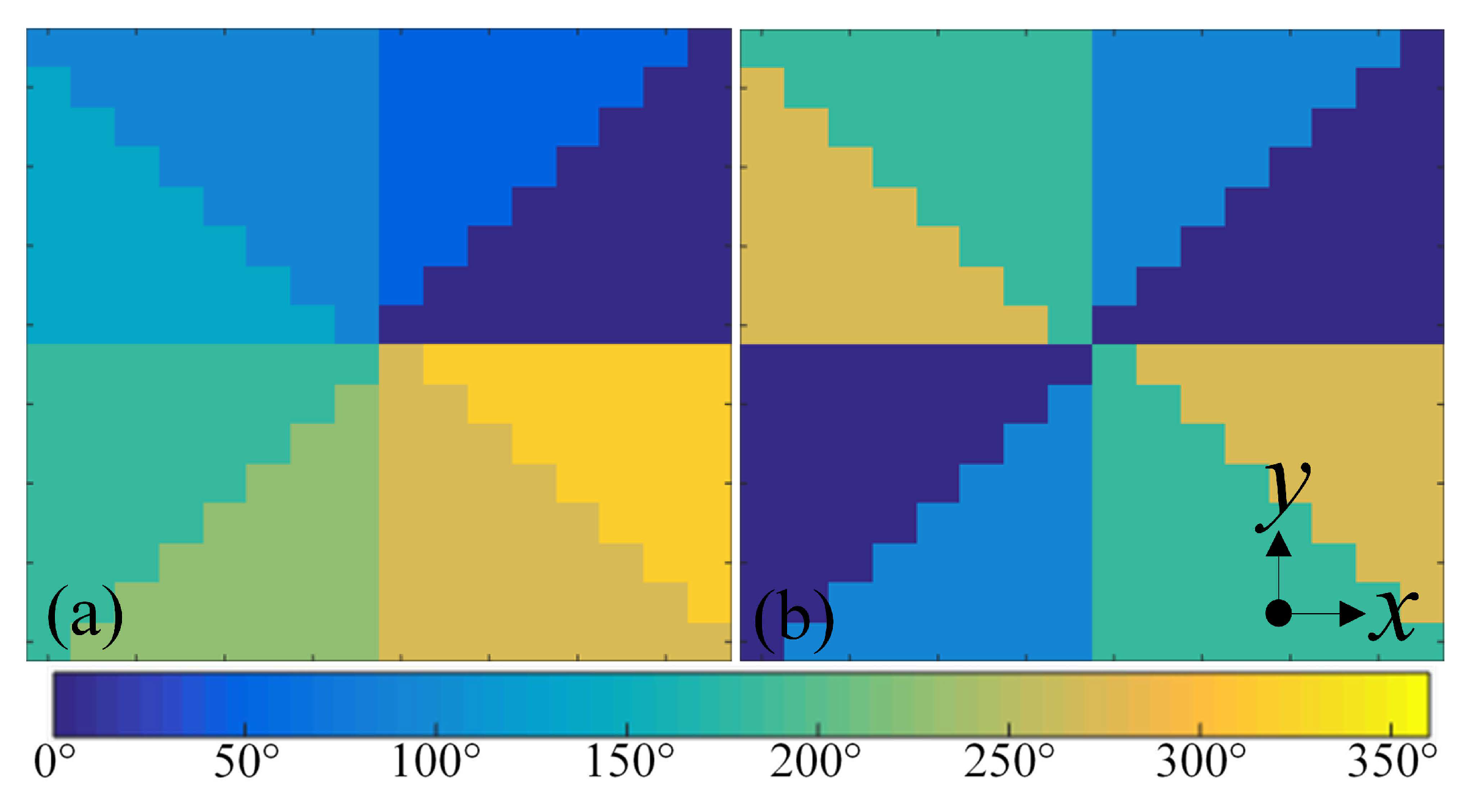

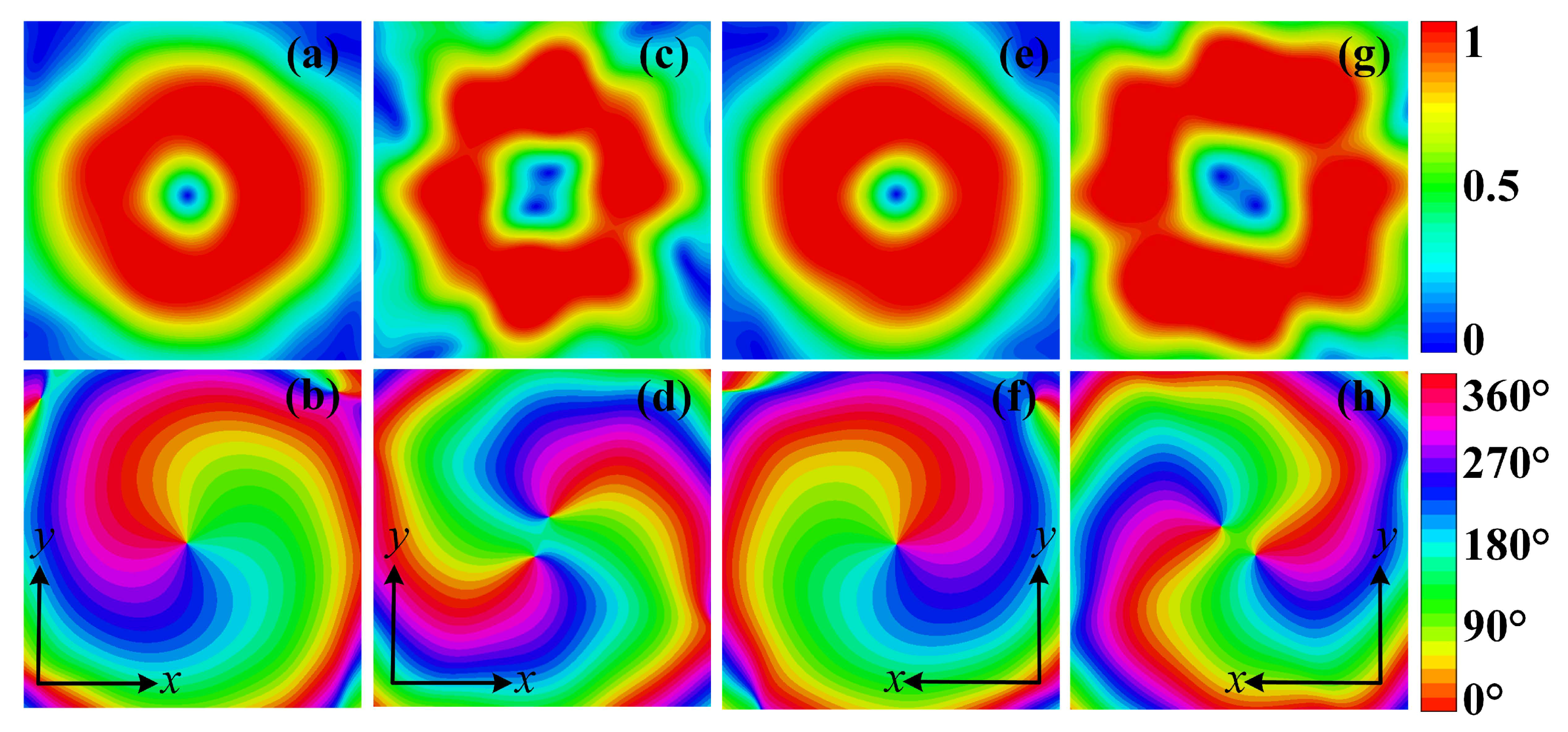

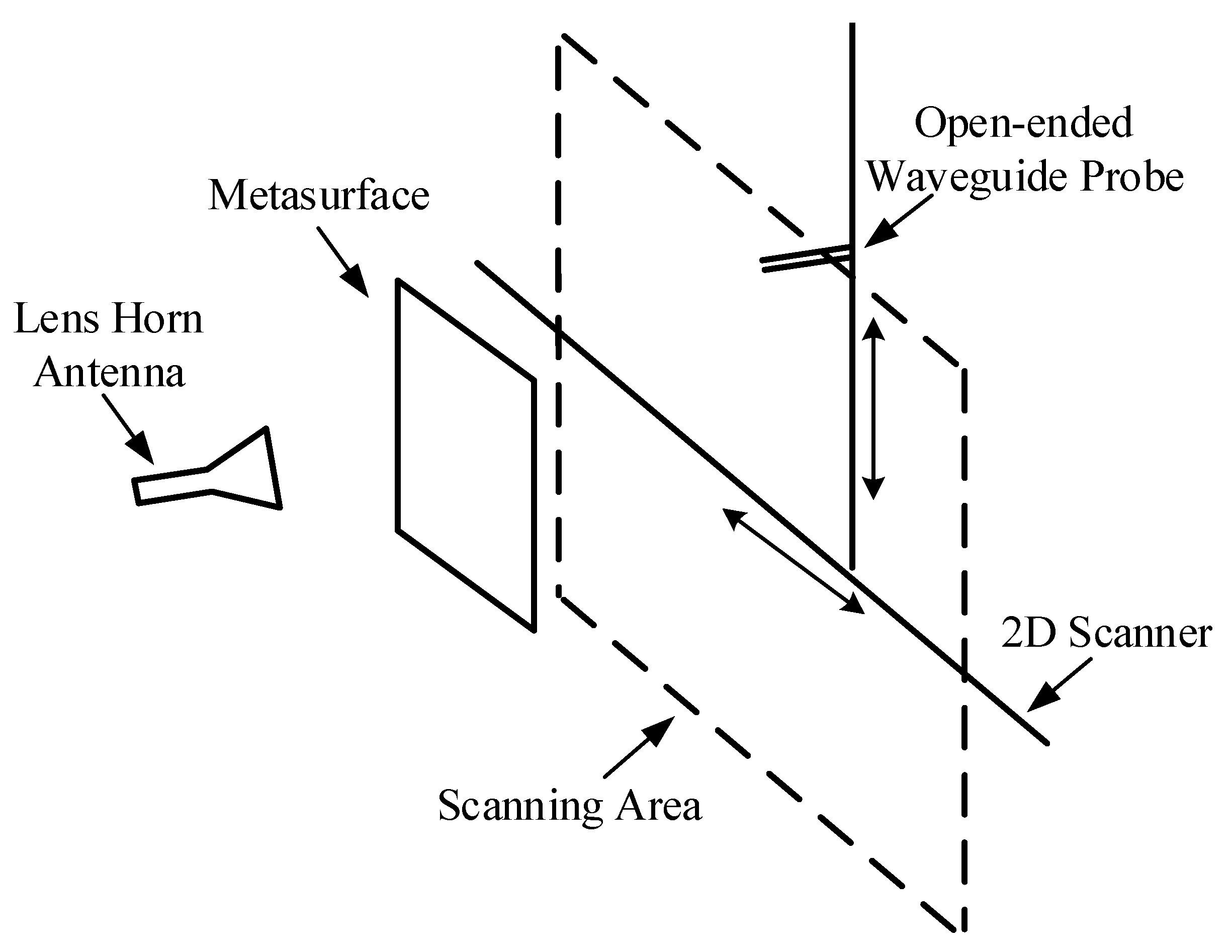

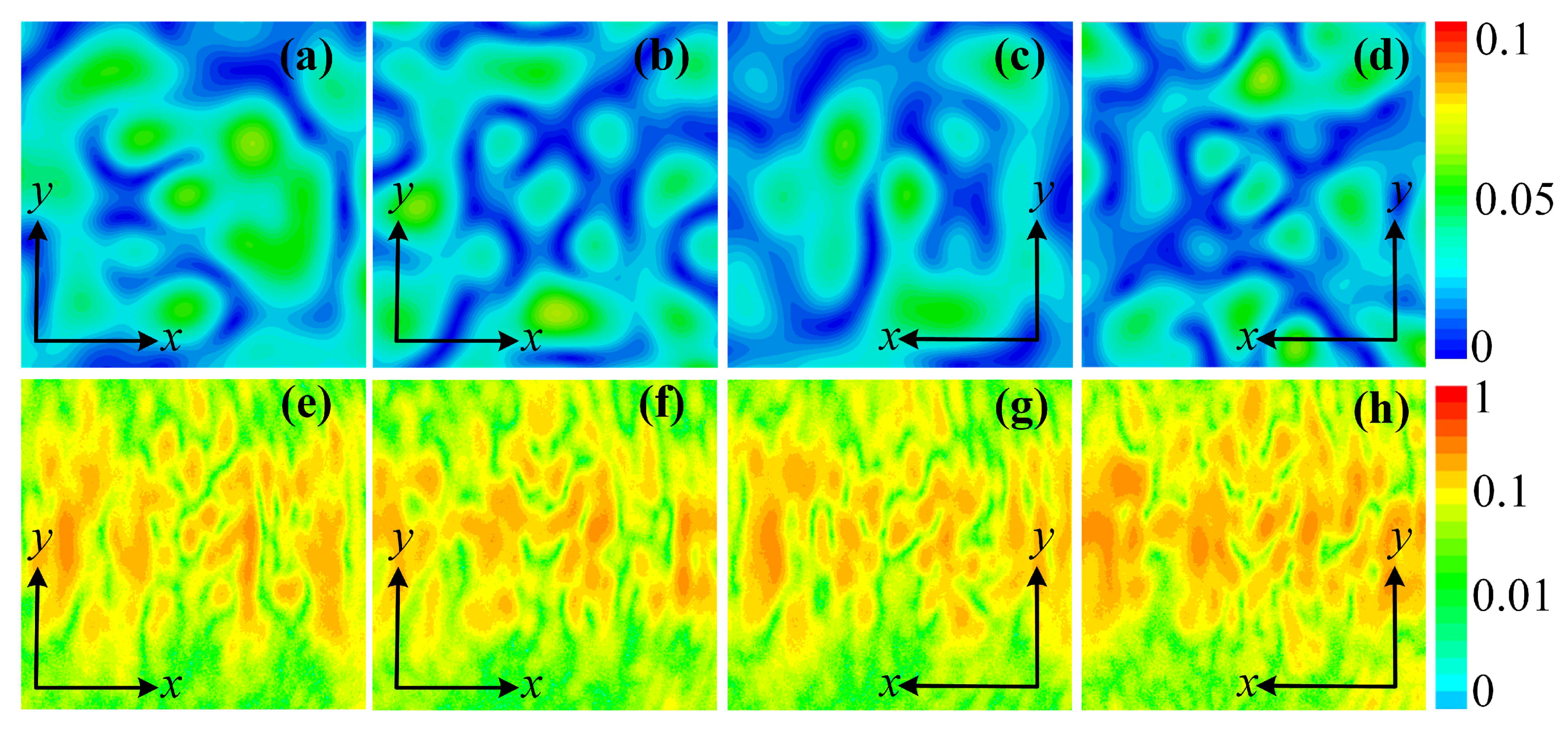
© 2018 by the authors. Licensee MDPI, Basel, Switzerland. This article is an open access article distributed under the terms and conditions of the Creative Commons Attribution (CC BY) license (http://creativecommons.org/licenses/by/4.0/).
Share and Cite
Shi, H.; Wang, L.; Zhao, M.; Chen, J.; Zhang, A.; Xu, Z. Transparent Metasurface for Generating Microwave Vortex Beams with Cross-Polarization Conversion. Materials 2018, 11, 2448. https://doi.org/10.3390/ma11122448
Shi H, Wang L, Zhao M, Chen J, Zhang A, Xu Z. Transparent Metasurface for Generating Microwave Vortex Beams with Cross-Polarization Conversion. Materials. 2018; 11(12):2448. https://doi.org/10.3390/ma11122448
Chicago/Turabian StyleShi, Hongyu, Luyi Wang, Mengran Zhao, Juan Chen, Anxue Zhang, and Zhuo Xu. 2018. "Transparent Metasurface for Generating Microwave Vortex Beams with Cross-Polarization Conversion" Materials 11, no. 12: 2448. https://doi.org/10.3390/ma11122448




